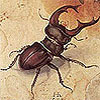|
Dutch painter. It is difficult to categorize him: he made a few still-lifes, but he is best known for his mysterious dark close-ups of
the live undergrowth of forest floors that give detailed views of wild flowers, weeds, thistles, and mushrooms animated by phosphorescent butterflies,
insects, reptiles, and snakes. These works, strictly speaking not still-lifes, have always appealed to collectors of highly finished Dutch cabinet pictures.
Naturalists have a field day identifying their flora and fauna, and so do iconographers who give detailed commentaries on their content, which are generally related to the transience theme.
Van Schrieck travelled to Italy in 1648. In Rome he received the Bent name 'Sniffer' (Snuffelaer), because, according to Houbraken, he sniffed
everywhere for strange creatures and plants. He returned to his homeland a few years later. After settling in Amsterdam, he acquired a parcel
of land just outside the city where he kept animals and reptiles.
No doubts some are portrayed in his paintings.
link
Biography
Otto Marseus van Schrieck was a Dutch painter. According to Houbraken, he travelled to Italy and stayed in Rome and Florence with the painters Matthias Withoos and Willem van Aelst, the latter his pupil at the time.
Among his patrons were Ferdinando II de▓ Medici, Grand Duke of Tuscany. Van Hoogstraten claimed that he met van Schrieck in Rome as late as 1652. In Rome, van Schrieck was a member of the Schildersbent. About 1657 he returned with van Aelst to Amsterdam, where he had a small property and got married on 25 April 1664. An inventory of the contents of his house was made in July 1678, shortly after his death, in which more than 300 paintings are listed. Besides his own paintings, there were works by Cornelis van Poelenburch, Simon de Vlieger, Ludolf Bakhuizen, Jan Wijnants, Lucas van Leyden and van Aelst.
The work of van Schrieck occupies a special place among Dutch still-life painters. He specialized in accurate depictions of insects, reptiles and amphibians, set against a small area of the forest floor or dunes with a variety of flora, including moss, grass or herbs. He was as interested in representing the behaviour of the animals towards one another as he was their external appearance: thus a snake tries to catch a butterfly, or two lizards attack each other. The plants and animals depicted often contain symbolic allusions. The compositions almost always have a narrative character, whether light and pleasant, or more threatening. His still-lifes were imitated by his pupil Rachel Ruysch and by the Italian Paolo Porpora, among others.
link
Collections
Otto Marseus van Schrieck is represented in the following collections: Rijksmuseum, Amsterdam; The Louvre, Paris; Metropolitan Museum of Art, New York; Museum of Fine Arts, Boston ; Fitzwilliam Museum, Cambridge; Musée des Augustins, Toulouse; State Museums of Florence, amongst others.
|
